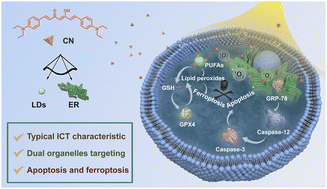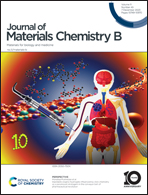A dual organelle-targeting photosensitizer based on curcumin for enhanced photodynamic therapy†
Abstract
The efficiency of photodynamic therapy (PDT) is related to the subcellular localization of photosensitizers (PSs) because organelles are associated with many fundamental life-sustaining activities. In this work, we synthesized a PS (CN) based on curcumin (CUR) and obtained enhanced PDT efficiency by simultaneously targeting lipid droplets (LDs) and the endoplasmic reticulum (ER). Compared with CUR, CN with a D–π–A–π–D structure possessed stronger intramolecular charge transfer features, resulting in longer absorption and emission wavelengths. In cell imaging experiments of CN using a confocal laser scanning microscope, a bright green emission in LDs and a weak orange emission in the ER were simultaneously observed due to its sensitivity to polarity. Surprisingly, CN with low singlet oxygen yields (0.13) exhibited an excellent photodynamic effect. Further experimental results showed that the phototoxicity of CN resulted in apoptosis by destroying the ER and ferroptosis by oxidizing polyunsaturated fatty acids (PUFAs) in LDs. This work paves the way for developing more effective photosensitizers with superior dual-targeting specificity.

- This article is part of the themed collection: Journal of Materials Chemistry B HOT Papers


 Please wait while we load your content...
Please wait while we load your content...